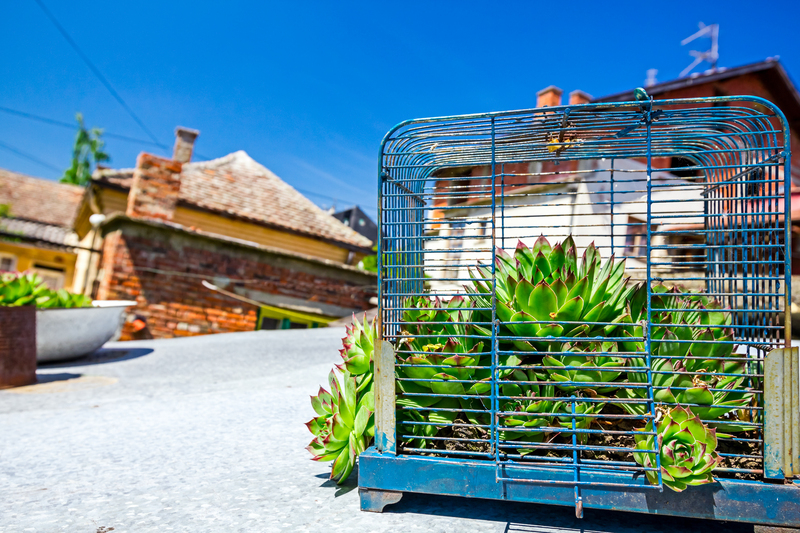Step into the world of vertical gardening
Posted on 11/06/2025
Step Into the World of Vertical Gardening: A Modern Green Revolution
Are you dreaming of lush green spaces, but feel constrained by limited room? Step into the world of vertical gardening! This innovative gardening technique is transforming urban spaces and small yards alike, allowing anyone to enjoy a bounty of plants, flowers, and even vegetables by growing upward instead of outward.
What is Vertical Gardening?
Vertical gardening is the practice of growing plants on vertical surfaces, such as walls, trellises, towers, or shelves, instead of traditional horizontal gardens. This approach is ideal for city dwellers, apartment owners, or anyone looking to add a touch of nature to limited spaces, including patios, balconies, and rooftops.
- Maximizes space efficiency
- Improves air quality
- Creates visually stunning displays
The Benefits of Vertical Gardening
Why should you consider stepping into the world of vertical gardens? There are numerous advantages beyond simply saving space:
- Optimized Space Usage: Ideal for urban dwellers, vertical gardens make it possible to grow lush gardens in apartments, condos, or tiny yards.
- Improved Air Quality: Plants filter toxins and release oxygen, making your environment healthier and fresher.
- Natural Insulation: Green walls act as insulators, regulating indoor temperatures and reducing energy costs.
- Pest and Disease Control: Vertical planting can reduce exposure to ground-dwelling pests and minimize soil-borne diseases.
- Easy Maintenance: Many vertical systems are designed for ease of watering and harvesting, making maintenance simple and efficient.
- Beautiful Aesthetics: From vibrant flower walls to aromatic herb towers, vertical gardens turn bland spaces into eye-catching landscapes.
Popular Types of Vertical Gardens
The world of vertical gardening offers a vast array of designs and systems. Here are some creative approaches to growing upwards:
- Living Walls (Green Walls): Panels of plants grown vertically using hydroponics and mounted to indoor or outdoor walls.
- Trellis Gardens: Traditional support frames for climbing plants like beans, tomatoes, or ivy.
- Pocket Planters: Fabric or felt pockets that hold soil and individual plants, perfect for herbs and small flowers.
- Pallet Gardens: Recycled wooden pallets repurposed into vertical planters for vegetables or blooms.
- Tower Gardens: Stacked containers or modular systems, often used for growing leafy greens and kitchen herbs.
- Hanging Gardens: Plants suspended from ceilings or pergolas, including air plants and cascading flowers.
Best Plants for Vertical Gardening
Not all plants are equally suited for vertical environments. Success depends on selecting species that thrive in relatively shallow soil and consistent care. Here are some of the best options for vertical gardens:
- Succulents: Hardy, low-maintenance, and drought-tolerant - ideal for green walls.
- Herbs: Basil, mint, thyme, oregano, and chives flourish in pocket or tower systems.
- Ferns: Excellent for low-light vertical wall gardens indoors.
- Climbing Flowers: Mandevilla, morning glory, sweet peas, and clematis add color and fragrance.
- Leafy Greens: Lettuce, spinach, kale, and arugula thrive in vertical towers.
- Strawberries: Perfect for towers or hanging pockets.
- Trailing Vines: Pothos, philodendron, and ivy create lush, cascading effects.
How to Start Your Own Vertical Garden
Ready to step into the world of vertical gardening? Here's a step-by-step guide to launch your very own vertical paradise:
- Assess Your Space: Decide if your garden will be indoors, on a balcony, or against an outdoor wall.
- Choose Your System: Will you use planters, hanging baskets, shelves, or install a full green wall?
- Select Suitable Plants: Factor in sunlight, watering needs, and space constraints.
- Prepare Your Structure: Secure wall mounts, freestanding frames, or shelves, ensuring they can support the weight of soil and plants.
- Install Irrigation: Drip irrigation systems work well for vertical set-ups, ensuring even watering.
- Plant and Arrange: Place larger plants at the bottom, trailing or small species on top tiers.
- Maintain Regularly: Monitor moisture, prune as needed, and feed your plants for vibrant growth.
Design Tips for Stunning Vertical Gardens
Want your wall garden to be as beautiful as it is functional? Use these design tricks to make a bold statement:
- Mix Textures and Colors: Combine broad-leafed plants with delicate vines and bright blooms.
- Use Modular Panels: Allows flexibility and easy plant rearrangement for dynamic displays.
- Incorporate Edible Plants: Blend herbs and leafy greens for both beauty and harvest.
- Layer Heights: Arrange plants in tiers for depth and visual interest.
- Highlight with Lighting: Use LED grow lights for indoor gardens, or position your setup to maximize sunlight.
Sustainable Solutions in Vertical Planting
Eco-friendly gardening is at the heart of the vertical revolution. Many systems rely on recycled materials, efficient irrigation, and organic practices. Consider these sustainable options:
- Upcycle Materials: Use old pallets, plastic bottles, or reclaimed wood as planters.
- Rainwater Harvesting: Collect and reuse rainwater for irrigation.
- Smart Soil Choices: Opt for organic, lightweight soils that reduce the need for chemical fertilizers.
- Composting: Incorporate a mini compost system for plant nutrition and waste reduction.
Common Challenges and Solutions in Vertical Gardening
Like any gardening method, vertical gardening comes with its own challenges. Here's how to address the most common issues:
- Watering Evenly: Vertical systems can cause uneven water distribution. Use drip irrigation or self-watering planters to keep all tiers moist.
- Weight Support: Ensure your walls or frames can handle the combined load of soil, water, and plants--especially when fully watered.
- Sunlight Access: Upper plants may shade those below. Rotate plants or install adjustable shelves for optimal light exposure.
- Plant Health: Keep an eye out for pests and diseases, and choose disease-resistant varieties whenever possible.
Vertical Gardening for Urban Living
Stepping into the world of vertical gardening is especially transformative for city residents. With skyrocketing rents and diminishing green space, vertical gardens provide a tangible way to reconnect with nature, grow fresh produce, and beautify apartment balconies or city rooftops.
- Indoor Plant Walls: Bring the outdoors inside and cleanse your apartment's air.
- Rooftop Green Spaces: Cool your building and cultivate veggies for your table.
- Community Vertical Gardens: Share resources and knowledge with neighbors while greening your surroundings.
Case in Point: Major metropolitan areas such as New York, London, and Tokyo feature vertical gardens on skyscraper facades, restaurants, and community centers--proof that the movement is reshaping urban landscapes worldwide.
Step-by-Step Example: Building a DIY Vertical Garden
Want to try it yourself? Here's a simple way to create a vertical herb garden using a wooden pallet:
- Step 1: Select a clean, sturdy wooden pallet.
- Step 2: Secure landscaping fabric to the back and bottom to hold soil.
- Step 3: Fill each pallet row with potting soil.
- Step 4: Plant herbs such as parsley, basil, and cilantro in the slots.
- Step 5: Water gently, ensuring moisture reaches all levels.
- Step 6: Set the pallet upright against a wall on your balcony or patio.
- Step 7: Harvest fresh herbs as needed and enjoy the beauty!
Vertical Gardening Trends and Innovations
The world of vertical gardening is constantly evolving. Here are some cutting-edge trends inspiring gardeners across the globe:
- Hydroponic Green Walls: Soil-free systems using nutrient-rich water, popular for indoor installations.
- Smart Vertical Gardens: Automated irrigation and lighting, controllable via smartphone apps.
- Edible Art: Arrangements that fuse food plants and ornamental species for dual-purpose gardening.
- Modular Living Walls: Easily expandable panels designed for custom layouts and plant swaps.
Resources and Inspiration: Dive Deeper into Vertical Gardening
- Books: "The Vertical Garden" by Patrick Blanc, "Vertical Gardening: Grow Up, Not Out" by Derek Fell.
- Online Communities: Join forums and social media groups for tips and inspiration from fellow enthusiasts.
- Garden Centers: Many local nurseries now offer vertical garden kits and workshops.
- Video Tutorials: Platforms like YouTube abound with step-by-step guides and creative solutions.
Conclusion: Why Step Into the World of Vertical Gardening?
Whether you're a seasoned gardener or complete beginner, stepping into the world of vertical gardening opens new possibilities for creativity, sustainability, and wellness. With so many design options, plant choices, and innovative technologies, it's easier than ever to transform bland walls or tiny spaces into living masterpieces.
Ready to reach new heights in your gardening journey? Embrace the world of vertical gardens and enjoy greener, healthier, and beautifully inspiring spaces right where you live.



